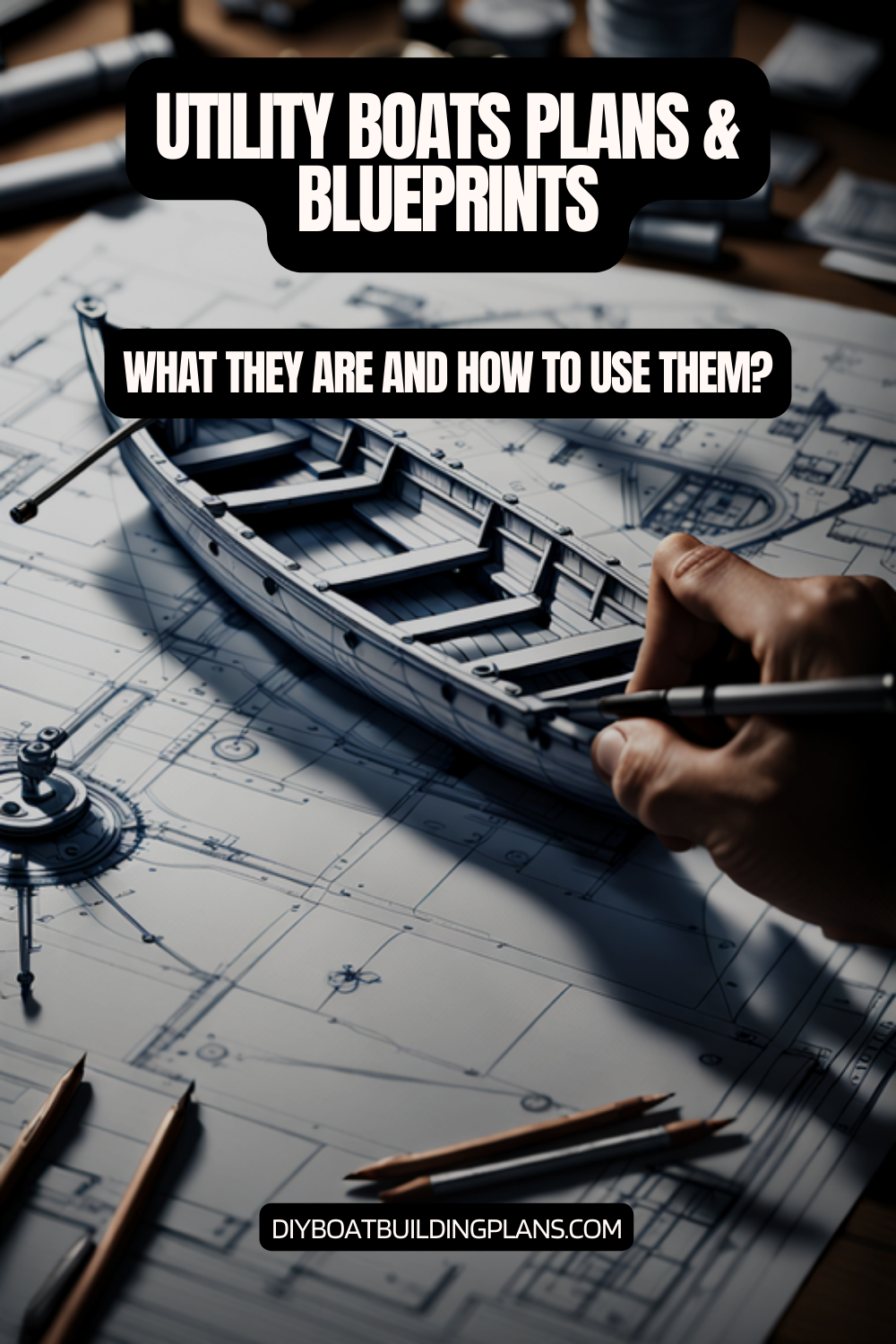Are you ready to turn your weekend hobby into a real adventure on the water? Imagine building your own boat with just some plans, determination, and a love for wooden boats.
The DIY utility boat world is full of exciting possibilities for those who love the sea. With 719 unique plans and blueprints, you can make your dream boat come true.
From small 12-foot boats to big 106-foot ones, the design options are endless. If you’re willing to put in the time and effort, you can make your nautical dreams a reality.
Key Takeaways – Utility Boats Plans & Blueprints
- Discover 719 unique DIY utility boat plans and blueprints
- Learn boat building techniques across various design styles
- Explore materials from wood/epoxy to aluminum and fiberglass
- Choose from designs ranging from 21 to 106 feet in length
- Select boat types including trawlers, sport fishermen, and recreational vessels

Introduction to DIY Utility Boats
Starting a DIY utility boat project is exciting. It lets you be creative, learn new skills, and feel proud of your work. Small utility boat designs are a great way to turn materials into a real boat with the help of guides.
Building your own boat is more than a hobby. It’s a journey that mixes craftsmanship, engineering, and passion. You get to make a boat that fits your needs and likes perfectly.
Benefits of Building Your Own Boat
- Cost-effective alternative to purchasing pre-made boats
- Complete customization of design and features
- Develops valuable woodworking and marine construction skills
- Sense of pride and accomplishment in creating a functional watercraft
- Opportunity to learn about boat design and marine engineering
Understanding the Basics of Boat Design
Starting a DIY boat project means learning the basics of design. Each boat type needs special thought based on its use, the water, and what you like.
| Boat Type | Best Use | Difficulty Level |
|---|---|---|
| Kayaks | Recreational paddling | Beginner |
| Dinghies | Sailing, fishing | Intermediate |
| Skiffs | Multiple purposes | Advanced |
“The joy of boat building is not just in the destination, but in the journey of creation.” – Traditional Boat Builder’s Wisdom
When building a boat, focus on important design parts like the hull shape, the materials, and where you’ll use it. Small utility boat designs need careful planning and detail to work well and be safe.
Unlock the secrets to building your dream boat with MyBoatPlans! With detailed plans for over 518 boats and expert video tutorials, you’ll have everything you need to create your perfect vessel. Click here to begin your journey!
Types of DIY Utility Boats
DIY enthusiasts can find many exciting utility boat designs. These plans are budget-friendly and versatile. They’re great for fishing or just cruising for fun.
Building your own boat is exciting. There are many options for those who love the water. Knowing the different types helps you pick the right one for you.
Flat-Bottom Boats
Flat-bottom boats are a great choice for beginners. They’re:
- Stable for fishing
- Easy to build
- Good for shallow waters
- Have simple plans
V-Hull Boats
V-hull boats are great for different waters. They’re known for:
- Handling waves well
- Being fast and easy to steer
- Being a bit harder to build
- Working well in deeper waters
Jon Boats
Jon boats are loved for their simplicity and versatility. They’re perfect for:
- Fishing and hunting
- Smooth water trips
- Being light and easy to move
- Being affordable to make
| Boat Type | Best Use | Difficulty Level | Cost Estimate |
|---|---|---|---|
| Flat-Bottom | Fishing, Calm Waters | Beginner | $500-$1,500 |
| V-Hull | Rough Waters, Speed | Intermediate | $1,500-$3,000 |
| Jon Boat | Versatile Recreation | Beginner | $800-$2,000 |
“The joy of building your own boat is not just in the destination, but in the journey of creation.” – Unknown Boat Builder
Each boat type has its own benefits for DIY builders. Choosing the right one depends on your skills, what you plan to do with it, and your personal taste.
Essential Tools for Boat Building
Starting a DIY utility boat project needs careful tool selection. The right tools make building a boat fun and rewarding. Whether you’re new or experienced, knowing the key tools is vital for a successful build.
Having a good toolkit is key to successful boat building. The quality of your tools affects the precision and quality of your project.
Hand Tools for Precision Work
Hand tools are the foundation of boat building. Here are the essential hand tools:
- Measuring tools: Measuring tape, rulers, and squares
- Cutting implements: Japanese crosscut saws and utility knives
- Shaping tools: Chisels, planes, and spoke shaves
- Marking tools: Pencils, marking gauges, and bevel gauges
“In boat building, your tools are an extension of your craftsmanship.” – Professional Boat Builder
Power Tools for Efficient Construction
Power tools can make your boat building faster and more efficient. Consider getting:
- DEWALT DC970K-2 18-Volt Compact Drill/Driver Kit
- Jig saws for detailed cuts
- Sanders for smooth finishes
- Cordless screwdrivers
Professional builders say having many clamps and a diverse toolkit is important. Quality is more important than quantity when choosing tools for DIY utility boats plans.
Safety and Maintenance
Always wear protective gear for safety:
- Safety glasses
- Dust masks
- Protective gloves
Keep your tools in good shape for better performance. Clean, check, and store them right to keep them working well.
Selecting the Right Materials
Choosing the perfect materials is key in wooden boat construction. The success of your aluminum utility boat plans depends on high-quality materials. These materials must withstand water and provide durability.
The art of boat building requires careful consideration of various materials. Each material has unique characteristics and benefits.
Best Woods for Boat Building
For wooden boat construction, some woods are better than others. They offer exceptional qualities:
- Alaskan Yellow Cedar: Renowned for its water-resistant properties
- Clear Oregon Pine: Excellent for structural components
- White Oak: Incredibly durable for long-lasting boats
- African Ironbark: Known for extreme durability
Longevity of Boat Building Woods
“The right wood can make your boat last decades with proper care and maintenance.”
Different woods have varying lifespans in marine environments:
- Top-tier woods like African Ironbark can last up to 35 years
- Philippine Mahogany typically maintains integrity for 25-30 years
- Larch and Juniper provide reliable performance for two decades
Additional Materials for Utility Boats
Aluminum utility boat plans often use more than wood. Fiberglass, marine-grade plywood, and specialized marine aluminum are used. They offer lightweight and corrosion-resistant options for builders.
Professional boat builders suggest starting with smaller projects. This helps build expertise in material selection and construction techniques.
Step-by-Step Guide to Boat Building
Starting a DIY boatbuilding project needs careful planning and precise steps. Building your own boat is a fun mix of craftsmanship, creativity, and technical skills. It doesn’t matter if you’re into fiberglass or wooden boats; knowing the basics is key.
Before you start building, preparation is essential. Experts say a detailed approach is vital for a strong and performing boat.
Planning Your Design
Design planning is a big step:
- Create detailed sketches of your boat
- Develop full-size cardboard mock-ups
- Generate precise templates for key components
- Select appropriate materials based on boat type
Cutting and Shaping Materials
Preparing materials is a critical phase in boat building. A typical project might need:
- 78 individual timber pieces
- 2 sheets of 6mm Marine Ply
- 6 liters of epoxy resin
- Approximately 80 G clamps for securing pieces
“Precision in cutting and shaping determines the quality of your final boat” – Master Boat Builder
Assembly Techniques
Successful assembly uses several techniques:
- Fairing surfaces for precise fits
- Attaching plywood panels (planking)
- Using 748 hot-dipped galvanized screws
- Applying proper epoxy techniques
DIY boatbuilding guides stress the importance of patience and detail. With careful planning and execution, your dream boat can become a reality.
Safety Considerations in Boat Building
Building your own DIY utility boats needs careful safety steps. Whether you’re using boat design software or traditional DIY Utility Boats Plans & Blueprints, keeping yourself safe is key.
Download over 500 Boat Plans. Click on the link below.
-->Click Here<--
Personal Protective Equipment (PPE)
When working on boat projects, the right safety gear is essential. Start by choosing the right personal protective equipment:
- Safety glasses to protect eyes from debris
- Sturdy work gloves for hand protection
- Dust masks or respirators when sanding
- Ear protection when using power tools
- Steel-toed boots for foot protection
Safe Work Practices
Safe work practices make your boat-building space secure. Professional builders suggest these tips:
- Always work in a well-ventilated area
- Keep your workspace clean and organized
- Inspect tools before each use
- Use tools according to manufacturer instructions
- Take regular breaks to prevent fatigue
“Safety doesn’t happen by accident. It requires deliberate planning and consistent execution.” – Boat Building Safety Expert
| Safety Category | Recommended Practices |
|---|---|
| Tool Handling | Maintain sharp edges, use guards, unplug when not in use |
| Material Handling | Use proper lifting techniques, wear gloves, avoid overreaching |
| Chemical Safety | Read labels, use in ventilated areas, wear protective clothing |
Remember, a safe boat builder is a successful boat builder. Always put your safety first during the DIY Utility Boats Plans & Blueprints construction.
Understanding Boat Regulations
Building DIY utility boats means knowing the law and safety rules. It’s not just about making a boat. You also need to understand maritime laws.
Before you launch your DIY Utility Boats Plans & Blueprints, you must know the rules. It might seem hard, but it’s doable if you take it one step at a time.
Required Permits for DIY Boats
Getting the right permits is key for your boat project. Each place has its own rules. You’ll likely need to get:
- Local marine authority registration
- State-specific boating permits
- Hull identification number (HIN)
- Safety equipment certification
Safety Standards and Compliance
When making small utility boat designs, safety comes first. Important areas to focus on include:
| Safety Category | Key Requirements |
|---|---|
| Structural Integrity | Meet marine engineering standards |
| Flotation | Ensure proper buoyancy and stability |
| Equipment | Include required safety gear |
“Compliance is not just about following rules – it’s about ensuring the safety of everyone on the water.”
Pro tip: Contact local marine authorities early in your boat-building process to understand specific regional requirements for DIY utility boats.
Maintenance Tips for DIY Utility Boats
Keeping your homemade boat in top shape is key. Budget-friendly boat plans need regular care to last long and perform well. Good maintenance protects your investment and makes boating safe and fun.
Routine Checks and Repairs
Regular checks are vital for your DIY utility boat. Make a detailed maintenance checklist to keep track of your boat’s health:
- Inspect hull for cracks or damage every month
- Check all structural connections and fasteners
- Examine electrical systems and connections
- Verify safety equipment is functional
Cleaning and Care Strategies
Good cleaning keeps your boat looking great and running well. Here are some cleaning tips for your homemade boat blueprints:
- Rinse boat with fresh water after each use
- Conduct thorough cleaning weekly
- Use mild boat soap for deep cleaning
- Protect against mildew and corrosion
“Consistent maintenance is the key to preserving your DIY boat’s performance and value.”
| Maintenance Frequency | Key Actions |
|---|---|
| After Each Use | Rinse with fresh water, dry thoroughly |
| Weekly | Detailed cleaning, check equipment |
| Monthly | Comprehensive system inspection |
| Seasonal | Complete boat system overhaul |
Pro tip: Store your budget-friendly boat plans in a dry, protected area to prevent unnecessary wear and environmental damage.
Resources for Boat Builders
Starting a DIY boatbuilding project needs good resources. These can help guide and support you. Whether you’re new or have experience, the right info and community can greatly help your project.
Online Communities and Forums
Online platforms have changed how boat builders share and learn. There are many online resources to help your DIY boatbuilding:
- Specialized boat design software platforms
- Dedicated boat building forums
- Social media groups for marine enthusiasts
- YouTube channels with step-by-step tutorials
“The best learning comes from sharing experiences with fellow boat builders.” – Professional Boat Designer
Recommended Books and Manuals
For those serious about boat building, books and manuals are key. They offer deep insights into design, construction, and engineering.
- Classic wooden boat building manuals
- Modern boat design technical guides
- Marine engineering reference books
- Specialized boat construction handbooks
Our research shows access to a vast library of boat plans. Over 200 original designs are available in simple, step-by-step formats. These plans include cabin cruisers, sailboats, and fishing vessels.
Pro Tip: Digital boat design software can greatly help your project. It lets you visualize and refine your design before you start building.

Conclusion: Start Your DIY Boat Journey
Starting a DIY utility boat project is an exciting adventure. It lets you create your own watercraft. The DIY Utility Boats Plans & Blueprints offer a chance to turn raw materials into boats.
Choosing the right boat plan is important. You need to think about your skill level, budget, and how you’ll use the boat. Plans range from simple Jon boats to more complex designs. They vary in length and weight capacity.
Building a boat takes patience, precision, and passion. You’ll need good tools like saws and drills. Learning to read blueprints and understand materials is key. Customizing your boat, like choosing paint or adding storage, is part of the fun.
Building your own boat is more than just creating a vessel. It’s about learning craftsmanship and maritime design. It’s about the joy of bringing your idea to life. Take your time, stay safe, and enjoy every step of your DIY boat-building journey.
FAQ – Utility Boats Plans & Blueprints
What are the main advantages of building my own utility boat?
Building your own utility boat can save you money and let you customize it to your liking. It’s a fulfilling project that lets you create a boat that meets your exact needs. You’ll also learn valuable skills in boat construction and design.
What materials are best for building a DIY utility boat?
Popular materials for DIY boats include marine plywood, hardwoods, aluminum, and fiberglass. Marine plywood is light and affordable, while aluminum is durable. Fiberglass is great for water resistance. Choose based on your project, budget, and use.
How much do boat building plans typically cost?
Boat building plans can cost anywhere from $15 to $1,936. Prices vary based on design complexity, boat type, and blueprint detail. Simple designs like the Holly Point Skiff are cheaper, while complex designs cost more.
Do I need specialized tools to build a utility boat?
You’ll need both hand and power tools for building a utility boat. Hand tools like measuring tape and chisels are essential. Power tools like circular saws and drills make the job easier. Start with basic tools and add more as needed.
Are there legal considerations for building my own boat?
Yes, you must follow local and national boat regulations. This includes getting permits, meeting safety standards, and ensuring your boat fits size and usage requirements. Regulations differ by location and boat type.
How long does it typically take to build a DIY utility boat?
Building time varies based on design complexity, your skill level, and available time. Simple designs can take weeks, while complex ones might take months. Your experience and available time affect the build time.
What safety precautions should I take when building a boat?
Always wear safety gear like glasses and gloves. Work in a well-ventilated area and keep your workspace clean. Follow safe tool handling practices. Prioritize safety throughout the project.
Where can I find resources and support for DIY boat building?
Great resources include online forums, websites like Classic Wooden Boat Plans, books, DVDs, and local classes. Online communities offer advice, troubleshooting, and support. They’re invaluable during your boat building journey.



